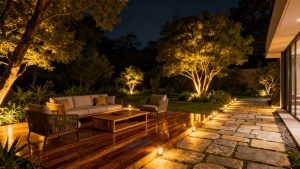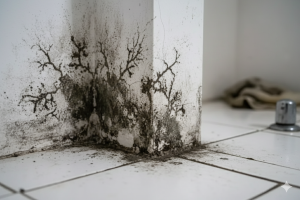Last Updated on June 18, 2025 by teamobn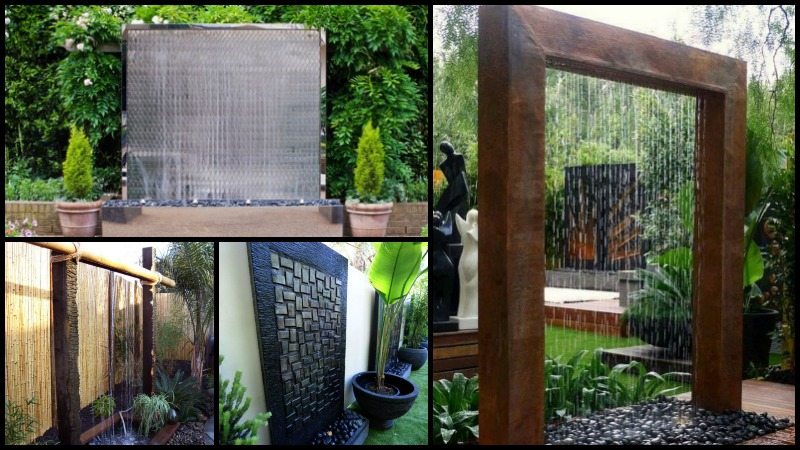

A water feature can enhance any garden, patio, or home. They not only give the place a serene atmosphere, but these water walls are also great for decoration.
The gentle sounds of steadily flowing water are pleasant to the ears and relaxing to an exhausted mind and body. That’s why having a water feature is great if you want a more serene ambiance at home.
Now one of the many options you can look at when it comes to water features is a water wall.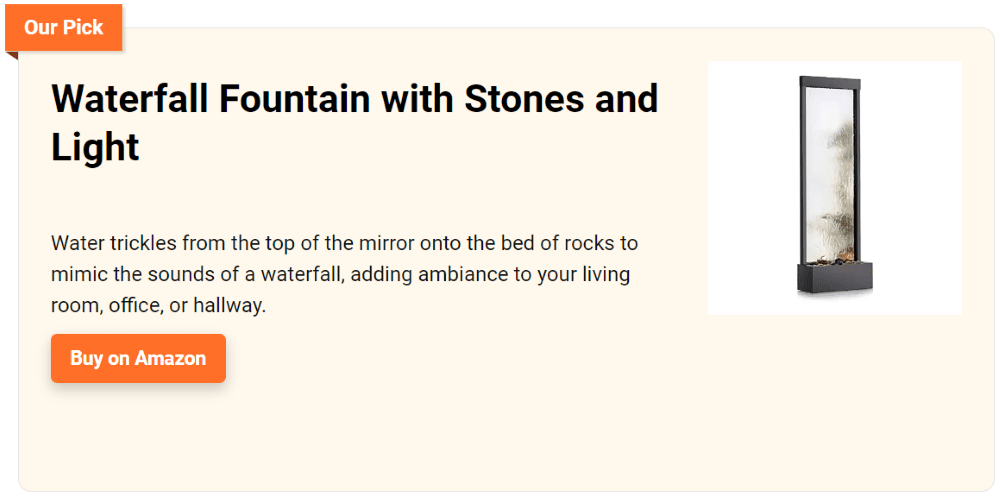

Water walls are a decorative feature that imitates a waterfall with a stream of water. Water walls are especially popular as outdoor features due to the way they bring natural elements into the landscape and fill an otherwise boring (or empty) space.
It features a small pump that sends water towards the wall at a continuous rate. If you want a water feature that can also serve as the main ‘decorative feature‘ in your home/garden then a water wall is a good option for you.
It looks large, yet it doesn’t take a lot of horizontal space. It’s great for making a relatively small space appear larger than it actually is.
Though they are called such because they are ‘water on a wall’, they can also be located in the middle of a garden or room and can even serve as some sort of divider. This of course is most fitting for wide spaces.
There are several water feature ideas you can choose from to suit your home and taste. The list below shows some examples of the various types of water walls for your inspiration.
What kind of water wall would you like to have in your home?
Click on any image to start the lightbox display. Use your Esc key to close the lightbox. You can also view the images as a slideshow if you prefer ![]()
![]()
Copper
Copper water walls are great decorative and functional water features, which help to enhance and beautify the landscape while providing a soothing, relaxing and beautiful source of sound and visual interest. They are a great way to use water, and they can be used indoors or outdoors.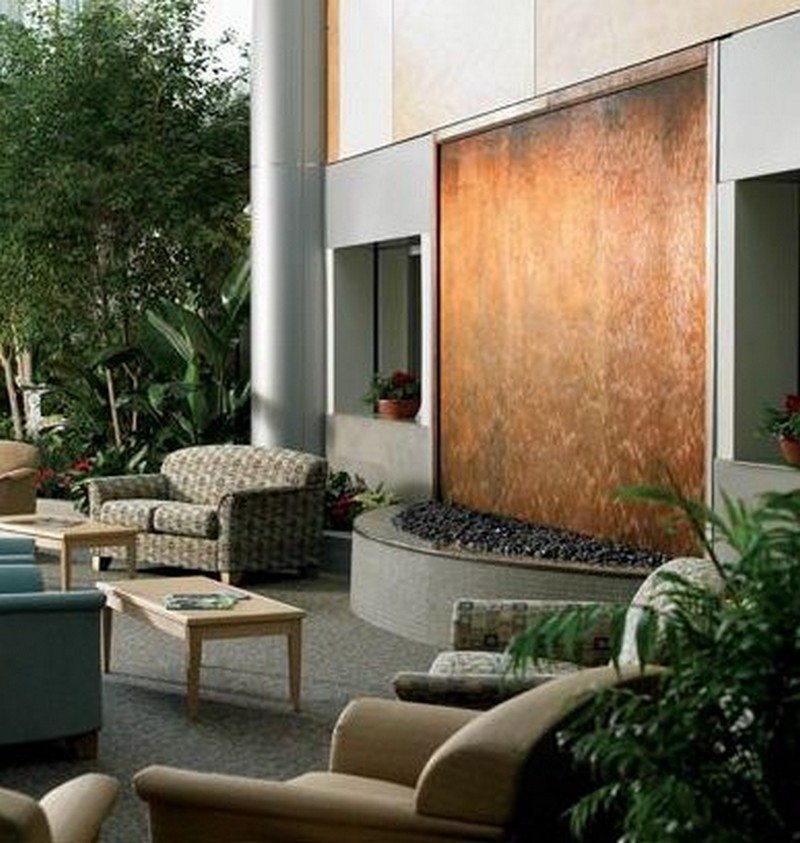





Glass
These water walls are created by a system of water pumps and glass panels. They are specifically used to deliver an increased volume of water to an area that needs it.
The pumps use the increased volume of water to deliver a strong force that is directed at the glass panels. This causes the water to travel up and then down the wall.

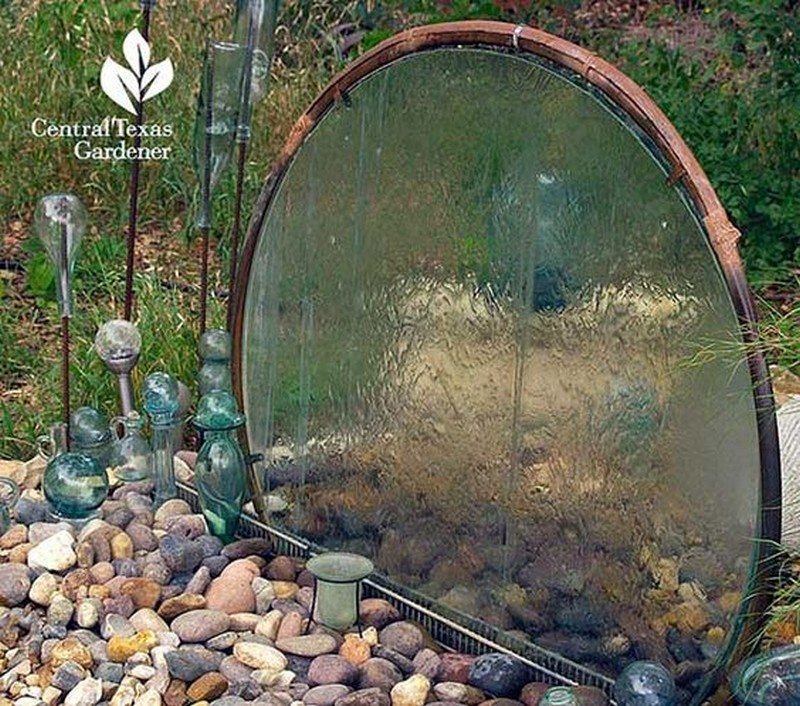

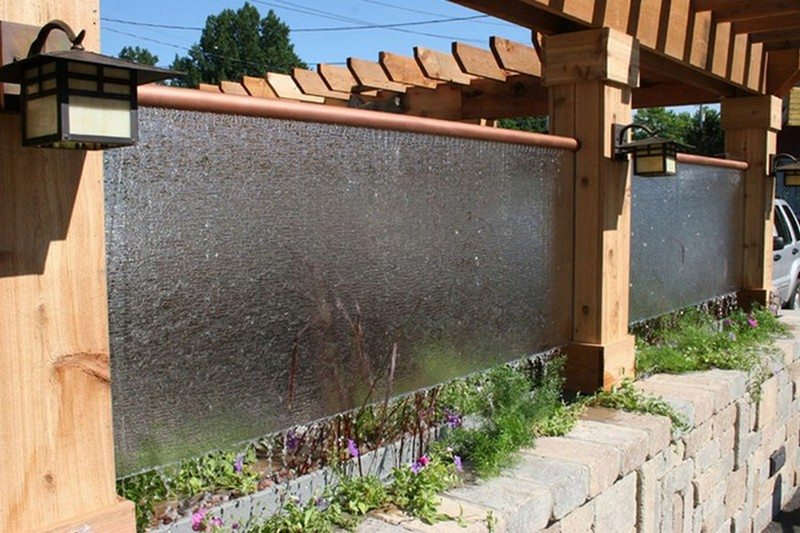

Stones
A water wall using stones is the perfect way to add water features to your landscaping. Stones used in these water features are of different shapes and sizes.
Their textures, colour, and grooves make the water feature looks natural and beautiful. Water wall using stones is a good way to help you save money.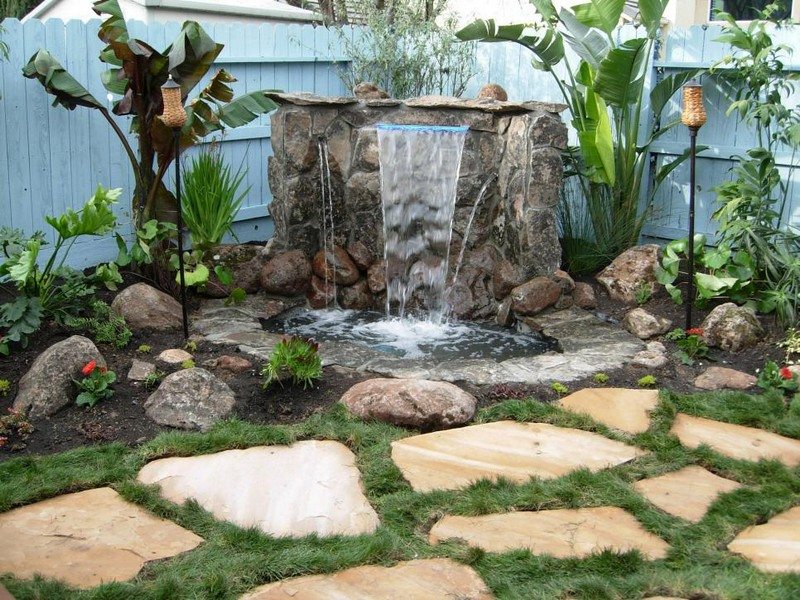





Stainless Steel
This water wall is made up of stainless steel, the material is highly resistant to corrosion by water. The water is sent to the top of the wall by pumps and then falls to the bottom of the wall by gravity.
There are also wind power-driven water walls which use wind power to move the water. The water wall circulates the water in a tank and sends the water to the top of the wall.





Rain Shower
This water wall provides an alternative to a regular shower. It has a long backlit panel that resembles a vertical stack of windows, which gently and slowly fills with water.
The panel is attached to a motor that rotates a large disc and dispenses water as it fills up. When the disc is rotated to its maximum extent, it sprays water out through the gaps in the backlit panel and onto the shower floor, creating a gentle rain shower effect.

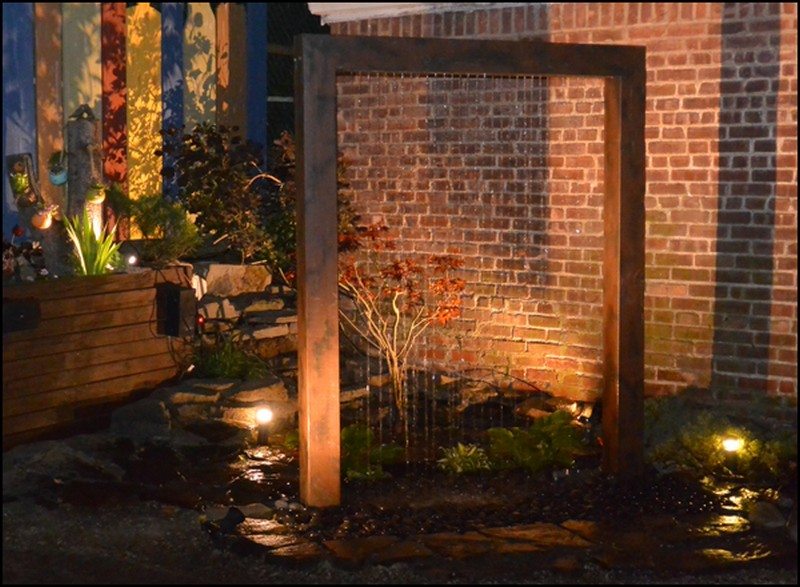



Indoor
Indoor water walls bring a striking focal point into your home or office. They use sleek panels of glass, stone, or metal to channel a thin sheet of water for a modern look. You can mount them against a living room wall or place them as freestanding dividers in open spaces. They add natural humidity and help mask background noise with gentle, continuous flow.

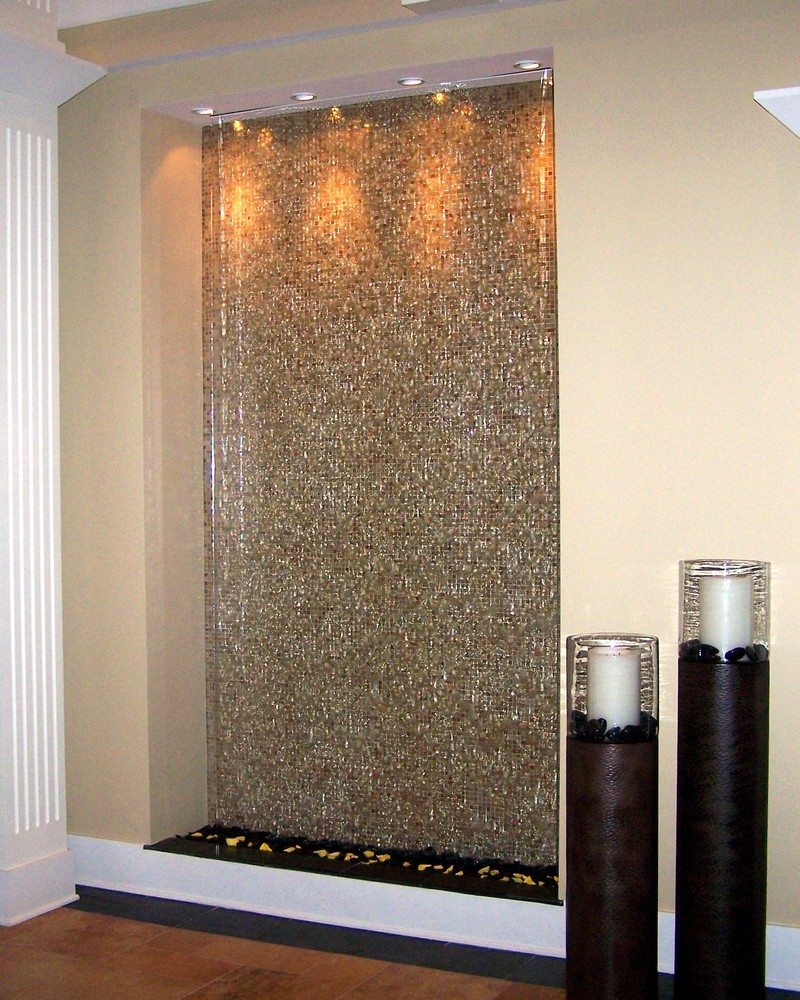



Materials and Finishes for Stunning Water Walls
Choosing the right material can transform any water wall into a work of art. The finish you pick affects both style and durability.
Natural Stone Elements
Natural stone brings organic beauty to any water wall. You can use slate, granite, or limestone. Each type features unique color and texture. Rough edges add rustic charm while honed finishes feel refined.
Water flows over uneven surfaces to create soft ripples. Natural stone demands a strong support structure for safety. It works indoors against a simple backdrop and outdoors near plants and paths. Over time stone develops a subtle patina that deepens its character.
Sleek Glass Panels
Glass panels create a clean, modern look. You can choose tempered or laminated glass. Clear glass gives an uninterrupted view of flowing water. Frosted or tinted options hide the pump and plumbing. Light behind the glass casts a soft glow at night.
Installation demands precise leveling and sealing to prevent leaks. Glass walls resist corrosion and allow easy cleaning. They pair well with metal or stone accents for contrast and style.
Warm Copper Accents
Copper brings warmth and an inviting hue. Over time a natural patina will soften the shine. You can bend thin copper sheets around frames for custom shapes. Fabricated copper channels complement a variety of design styles. Water glides over the warm metal surface. Custom panels may feature embossing or subtle etchings for depth.
Copper channels integrate easily with LED lighting to highlight flow at night. Polished or brushed finishes let you balance shine and texture. Copper adds a rich focal point that ages gracefully.
Polished Stainless Steel
Stainless steel offers a sleek industrial look. It resists corrosion and holds its finish over time. You can choose brushed or mirrored surfaces for different effects. Water flows down the flat steel plane in a smooth sheet.
Steel panels match modern décor and pair nicely with wood accents. Installation requires a precise frame and quality seals to prevent leaks. Thin steel veneers also work on curved surfaces. The material reflects light and surroundings beautifully.
Composite and Resin Options
Composite panels combine strength with light weight. You can mold them into bespoke shapes and textures. Resin finishes replicate stone, wood, or metal without heavy support. They resist cracking, fading, and fungus. Composite walls often include
UV stabilization for outdoor use. You can choose solid or backlit panels for dramatic effect. Installation is simple since panels come in modular sizes. Composite options offer budget-friendly versatility. They require minimal upkeep to retain color and finish.
DIY vs. Professional Installation: Pros and Cons
You might tackle a water wall project yourself to save money and learn new skills. Hiring skilled professionals can deliver expert results and avoid unexpected issues and hidden costs.
Cost Considerations
DIY often saves on labor costs but you still buy tools and materials you might not reuse. Shopping sales and repurposing items helps control spending. Repairs or leaks can drive up your budget quickly.
Professionals provide a clear upfront quote that covers labor, permits, and warranties. Their fees may include design and project management. You avoid surprise charges later. You will need to compare rental costs with service charges. Weigh both options before deciding.
Skill and Time Investment
Building a water wall requires plumbing, electrical, and construction skills. DIYers must learn pump installation, sealing, and troubleshooting. Time investment can stretch over weekends or months. You set the pace and avoid scheduling conflicts.
Professionals arrive with experience to finish projects quickly. Their teams coordinate trades and solve issues on the spot. You gain peace of mind but give up hands-on learning. Time saved may justify the extra cost.
Quality and Warranty
Your DIY outcome depends heavily on your skill level and planning. Errors in sealing or leveling can lead to leaks and costly repairs. Access to specialized finishes and high quality parts is limited for many homeowners.
Professionals back their work with labor warranties and product guarantees. They adhere to industry standards for material selection and installation techniques. If issues arise you receive prompt repairs at no extra cost. That peace of mind often outweighs higher fees.
Safety and Compliance
Installing pumps, plumbing, and electrical systems carries real risks. You must understand local building codes and secure the right permits. Mistakes in wiring or waterproofing can create safety hazards.
Professionals know regulations and handle code compliance from start to finish. They arrange inspections and secure approvals without delays. Contractors carry liability insurance that shields you from accidents. You avoid gaps in safety coverage and fines. Licensed installers reduce potential legal issues and ensure safe operation.
Customization and Support
DIY lets you craft every detail from material choice to panel layout. You can make real-time tweaks without extra charges. Complex elements like curved walls or integrated lighting may exceed home skills. Professionals offer design consultations with 3D renderings and precise plans. They advise on material selection and long-term maintenance. Ongoing support gives you a reliable point of contact for questions. Their experience can add design solutions you might not consider.

Placement and Sizing Tips for Indoor and Outdoor Spaces
Choosing the right spot ensures your water wall blends with surroundings and delivers maximum impact. Picking the right size prevents the feature from overwhelming or underwhelming its setting.
Finding Ideal Indoor Locations
Indoor water walls demand sturdy wall support that can handle water pressure and weight. You must position them close to electrical outlets and water lines for simple connections. Think about room traffic and function to avoid blocking pathways. Areas like entrance halls, living rooms, and home offices make impactful backdrops.
Keep them away from direct sunlight to reduce algae growth. Install moisture-resistant wall panels to protect finishes. Plan around existing décor and furnishings. Good placement ensures seamless integration.
Enhancing Outdoor Landscapes
Outdoor water walls add a focal point to gardens, patios, and courtyards. Position them against privacy screens or fences to create depth. Orient the wall to face seating areas so you enjoy the sound. Leave space for plants or decorative gravel at the base.
Avoid low spots that collect runoff. Hardscaped surfaces like pavers or stone slabs ease cleanup. Consider drainage and frost lines in colder climates. Outdoor walls can anchor fire pits or seating nooks too.
Matching Scale to Architecture
Your water wall should echo the lines and form of the building. A tall, narrow wall suits modern high ceilings and slim patios. Wide, low walls work with sprawling ranch-style homes and terraces. Measure height, width, and depth before planning.
Keep proportional gaps around the feature for balance. Oversized walls dwarf small rooms and sap intimacy. Undersized walls feel lost on large facades. Scale matching enhances curb appeal indoors and out.
Considering Sunlight and Wind
Sunlight affects water wall performance through algae growth and temperature shifts. West-facing walls receive harsh afternoon sun. East exposures get gentler morning light. Indoor walls rarely face this issue but outdoor walls need UV-stable finishes.
Wind can blow water off the surface. Use wind barriers or position walls in sheltered areas. You might add catch trays at the base. Outdoor orientation influences pump capacity and splash control. Planning for climate reduces maintenance.
Planning for Accessibility and Maintenance
Easy access makes cleaning, filtration, and repairs simple. Leave room around the pump housing and plumbing connections. Indoor walls benefit from removable panels for quick filter changes. Outdoor walls should include drain valves and access ports.
Plan safe electrical access in weatherproof enclosures. A lockable pump compartment prevents tampering. Consider adding a monitoring system that alerts you to low water levels. Accessible design extends the life of your water wall.
Conclusion
Choosing the right materials and finishes ensures your water wall stands out as a striking feature in any setting. Careful planning around installation options helps you balance budget, skill, and quality expectations. Thoughtful placement and accurate sizing let you integrate the wall seamlessly into indoor and outdoor environments.
Regular maintenance and accessible design keep your feature running smoothly and looking pristine. With these guidelines, you can create a water wall that captivates the eye and soothes the senses.
If you liked this, you might also like these landscaping and garden ideas…


